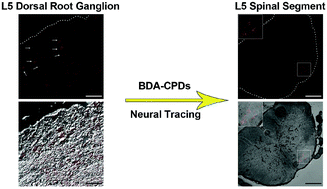A brand-new generation of fluorescent nano-neural tracers: biotinylated dextran amine conjugated carbonized polymer dots†
Abstract
The anterograde neuroanatomical tracing technique plays a crucial role in studying and charting the complex interconnections of the nervous system. But there are several major limitations for traditional neural tracers, such as complex immunohistochemical staining procedures, low fluorescence intensity and quick fluorescence quenching. Carbon dots (CDs) as fluorescent bio-probes have been widely used in the biological studies due to their superior optical properties, excellent chemical stability, low toxicity, and easy modifications. In this study, biotinylated dextran amine (BDA) and red fluorescent carbonized polymer dots (CPDs) are successfully conjugated to develop a brand-new generation of fluorescent nano-neural tracers: BDA–CPDs. They are successfully applied as fluorescent probes for in vitro and in vivo bioimaging. In vitro biodistribution of BDA–CPDs shows that they distribute mainly in lysosomes and endoplasmic reticulum. Moreover, two metabolic pathways of BDA–CPDs are found through the investigation of in vivo biodistribution of BDA–CPDs. Furthermore, they can be taken up and anterogradely transported by neurons within the peripheral nervous system of rats. Our results suggest that BDA–CPDs have many advantages over traditional tracers, such as low toxicity, high photoluminescence intensity, excellent photostability and easy procedures. Anterograde pathway tracing with BDA–CPDs is a simple, direct and economical way of studying the connections in the nervous system. Therefore, BDA–CPDs are reliable and valuable fluorescent anterograde neural tracers.



 Please wait while we load your content...
Please wait while we load your content...